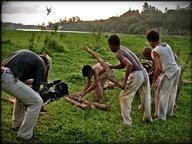Quiz Answer Key and Fun Facts
1. A slave owner states in his will that he does not want his enslaved people sold south or separated from their families and wants them freed. The slaves can be confident those wishes are legally binding and they won't be sold or separated when their master dies. Is that true or false, and why?
2. A trader purchases an enslaved woman in the country and takes her to the city of Richmond, Virginia, where she finds herself locked in a privately owned slave jail. She stays in a crowded cell at night and can walk out in a walled courtyard for exercise in the day. She hears other people being whipped in the jail and learns some are kept constantly chained. For what reasons, legally, could an enslaved person be confined in a privately owned antebellum slave jail?
3. At a slave auction house in the antebellum south, a man steps out and hangs a red flag on the front of the building. What does that mean?
4. At an antebellum slave auction, a woman in her twenties is being offered for sale. A male buyer wants to examine her to see if she is in good health for bearing children. What inspection would she typically have to endure?
5. An enslaved person is sold to a trader in the upper south and within a few days, finds himself grouped with dozens of others in the same situation for transportation to the trader's partner in New Orleans. This trader has chosen the cheapest method of traveling, though it's grueling for the enslaved people. They will walk the entire distance over several weeks, camping at night. For at least the first part of the trip, the adult male slaves and any others deemed likely to escape will have to walk shackled together. Such lines of people, attended by a wagon of camping gear and armed guards on horseback, were a common antebellum sight on main roads leading south. What were they usually called?
6. An enslaved man who is purchased by a trader discovers that rather than being forced to walk south, he will be put on board a ship with 150 others belonging to various traders and taken down the coast from Alexandria, Virginia to New Orleans. Though he will have to sleep on the bare deck or crowded in the hold, it's a shorter and less physically demanding trip than walking. What's a typical reason that a trader would choose this method for him, while sending others on foot?
7. An enslaved woman is sold in 1834 from her home in Maryland to Franklin and Armfield, traders in Alexandria. She is sent down the Atlantic coast in a brig with over a hundred others, rounding Florida and landing at New Orleans. There she and many of the others are transferred to a riverboat and taken up the Mississippi River, where she arrives at a collection of buildings for the housing and display of slaves for sale. In the Deep South, this sprawling slave market was second only to New Orleans' slave trading district in size. Its unimaginative name is taken from its convenient location. One could travel either to the Natchez Trace or the city of Natchez, Mississippi directly from the market, depending which road one chose. What is this major slave market called?
8. When an enslaved person arrives at an antebellum trader's pen in the Deep South, he or she must follow the trader's orders, including cooperating with the trader's tricks to make his merchandise seem as attractive as possible. If the enslaved person doesn't cooperate, he or she must fear physical punishment. Which of the following is NOT a typical practice of antebellum traders?
9. An enslaved man finds himself sold to a trader and waiting to be marched south. He requests: "My wife and son belong to Mr. Smith of Nashville, just a couple miles from here. I'm sure he'd sell them for a fair price. Can you buy them too so we can all stay together? I don't want to live without them."
What's the most common reason the trader might have decided to comply?
10. James Williams, sold from Virginia to Alabama in 1834, says, "It is an awful thing to a Virginia slave to be sold for the Alabama and Mississippi country. I have known some of them to die of grief, and others to commit suicide, on account of it." Which of the following was NOT a common reason for antebellum slaves to dread being sold further south?
Source: Author
littlepup
This quiz was reviewed by FunTrivia editor
gtho4 before going online.
Any errors found in FunTrivia content are routinely corrected through our feedback system.
